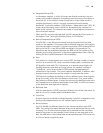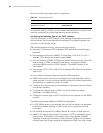
86 CHAPTER 5: IP ROUTING PROTOCOL OPERATION
Perform the following configurations in system view.
To ensure the stability of OSPF, you must determine the division of router IDs and
manually configure them when implementing network planning.
Configuring the Network Type on the OSPF Interface
The route calculation of OSPF is based on the topology of the adjacent network of
the local router. Each router describes the topology of its adjacent network and
transmits it to all the other routers.
OSPF divides networks into four types by link layer protocol:
■ Broadcast: If Ethernet or FDDI is adopted, OSFP defaults the network type to
broadcast.
■ Non-Broadcast Multi-access (NBMA): If Frame Relay, ATM, HDLC or X.25 is
adopted, OSPF defaults the network type to NBMA.
■ Point-to-Multipoint (P2MP): OSPF does not default the network type of any link
layer protocol to P2MP. The general undertaking is to change a partially
connected NBMA network to P2MP network, if the NBMA network is not
fully-meshed.
■ Point-to-point (P2P): If PPP, LAPB or POS is adopted, OSPF defaults the network
type to P2P.
As you configure the network type, consider the following points:
■ NBMA means that a network is non-broadcast and multi-accessible. ATM is a
typical example. You can configure the polling interval for hello packets before
the adjacency of neighboring routers is formed.
■ Configure the interface type to nonbroadcast on a broadcast network without
multi-access capability.
■ Configure the interface type to P2MP if not all the routers are directly
accessible on an NBMA network.
■ Change the interface type to P2P if the router has only one peer on the NBMA
network.
The differences between NBMA and P2MP are listed below:
■ In OSPF, NBMA refers to the networks that are fully connected, non-broadcast
and multi-accessible. However, a P2MP network is not required to be fully
connected.
■ DR and BDR are required on a NBMA network but not on a P2MP network.
■ NBMA is the default network type. For example, if ATM is adopted as the link
layer protocol, OSPF defaults the network type on the interface to NBMA,
regardless of whether the network is fully connected. P2MP is not the default
network type. No link layer protocols are regarded as P2MP. You must change
Table 26 Configuring Router ID
Operation Command
Configure router ID router id router-id
Remove the router ID undo router id


















